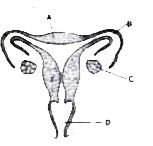Fertilisation in humans is practically feasible only if
i.The ovum and sperm are transported simultaneously to ampullary-isthmic junction of the cervix.
ii.The sperm are transported into cervix within 48 hours of release of ovum in uterus.
iii.The sperm are transported into vagina just after the release of ovum in fallopian tube.
iv.The ovum and sperm are transported simultaneously to ampullary-isthmic junction of the fallopian tube.
the sperms are transported into vagina just after the release of ovum in fallopian tube
the ovum and sperms are transported simultaneously to ampullary isthmic junction of the fallopian tube
the ovum and sperms are transported simultaneously to ampullary- isthmic junctino of the cervix
the sperms are transported into cervix within 48 hrs of release of ovum in uterus
Step by step video solution for Fertilisation in humans is practically feasible only if i.The ovum and sperm are transported simultaneously to ampullary-isthmic junction of the cervix. ii.The sperm are transported into cervix within 48 hours of release of ovum in uterus. iii.The sperm are transported into vagina just after the release of ovum in fallopian tube. iv.The ovum and sperm are transported simultaneously to ampullary-isthmic junction of the fallopian tube. by Biology experts to help you in doubts & scoring excellent marks in Class 12 exams.
Updated on:21/07/2023Similar Questions
A : All copulations do not lead to fertilisation and pregnancy .
R : Fertillsation can occur if the ovum and sperms are transported simultaneously to the ampullary - isthmic junction
View SolutionAssertion: All copulations do not lead to the fertilisation and pregnancy.
Reason: Fertilisation can occur only if the ovum and sperms are transported simultaneously to the ampullary isthmic junction.
View Solution
Knowledge Check
Fill up the blanks in the following paragraph by selecting the correct option.
During copulation (coitus) semen is released by the penis into the vagina and is called (i)._____.the ovum released by the ovary is transported to the (ii)._____where (iii).______takes place during fertilisation, a sperm comes in contact with the zona pellucida layer of the ovum and induces changes in the membrane that block the entry of (iv)._____The secretions of the (v)._____help the sperm enter into the cytoplasm of the ovum.A(i)(ii)(iii)(iv)(v)FertilisationFimbriaeinseminationeggsmiddle pieceB(i)(ii)(iii)(iv)(v)inseminationampullary isthmic junctionfertilisationadditional spermsacrosomeC(i)(ii)(iii)(iv)(v)ovulationampullafertilisationadditional spermstailD(i)(ii)(iii)(iv)(v)parturitionisthmusinseminationeggsacrosome
Ovum released from ovary and is transported to the fallopian tube for fertilisation . Trace the correct path the egg and embryo takes from ovary to uterus .
View SolutionWhich of the following statements regarding fertilization is/are correct ?
(i) The acrosome is filled with hydrolytic enzymes which help in dissolving the membrane of the ovum at the time of fertilization.
(ii) Vitelline membrane is the first membrane to be faced by sperms while trying to fuse with the ovum .
(iii) There must be synchronicity in the release of ovum and entry of sperm for the formation of zygote .
(iv) The meiotic division of the secondary oocyte is concluded with the entry of male gamete.
View Solutionwhich of the following statements regarding fertilization and implantation are incorrect ?
I. During fertilization , a sperm first comes in contact with the corona radiata cells produced by the ovum.
II. Fertilization occurs only if sperm and ovum are simultaneously transported to the ampullary region.
III. Implantation occurs about 7 days after fertilization .
IV. The continuous division of morula leads to the formation of zygote.
View SolutionThe figure given below represents the female reproductive system of a mammal. Parts indicated by the guidelines A to D are as follows:

(A) Uterus
(B) Fallopian tube (oviduct)
(C) Ovary
(D) Vagina
(a) Give appropriate terms for each of the following:
(i) The onset of reproductive phase in a young female.
(ii) Rupture of follicle and release of ovum from the ovary
(iii) Monthly discharge of blood and disintegrated tissues in human female.
(iv) Process of fusion of ovum and sperm.
(v) Fixing of developing zygote on the uterine wall.
(vi) The permanent stoppage of menstruation at about the age of 45 years in a female.
(b) State the functions of the (0) Placenta (ii) Amniotic fluid. [ICSE 2004, 2015]
(c) Using the symbol "X' indicates the region in the diagram where fertilisation occurs.[ICSE 2004)
View SolutionGiven below is a diagram of the reproductive system of a human female :

(i) Name the parts numbered 1-6.
(ii) Normally after how many days does an ovary release an egg?
(iii) Where are the sperms released during coitus?
(iv) What do the sperms do after being released ?
(V) What is the function of the organ numbered 5 ?
(vi) How many days does it normally take from the fertilisation of the egg up to the birth of the baby?
View SolutionFill up the blanks in the following paragraph by selecting the correct option
A. i___ methods work on the principle of avoiding chances of ovum and sperms meeting
B. ii___ is one such method in which the couples avoid coitus from day 10 to 17 of the menstrual cycle
C. iii___ is another method in which the male partner withdraws his penis from the vagina just before ejaculation so as to avoid insemination
D. iv___ method is based on the fact that ovulation and therefore the cycle do not occur during the period of intense loctation following parturition.
View SolutionMatch column I (terms) with column II (definitions) and select the correct option from the codes given below.
Column IColumn II(A)Parturition(i)Attachment of embryo to endometrium(B)Gestation(ii)Release of ovum from Graafian follicle(C)Ovulation(iii)Delivery of baby from uterus(D)Implantation(iv)Duration between pregnancy and birth(E)Conception(v)Fomation of zygote by fusion of the ovum and spermStoppage of ovulation and menstruation
View Solution
